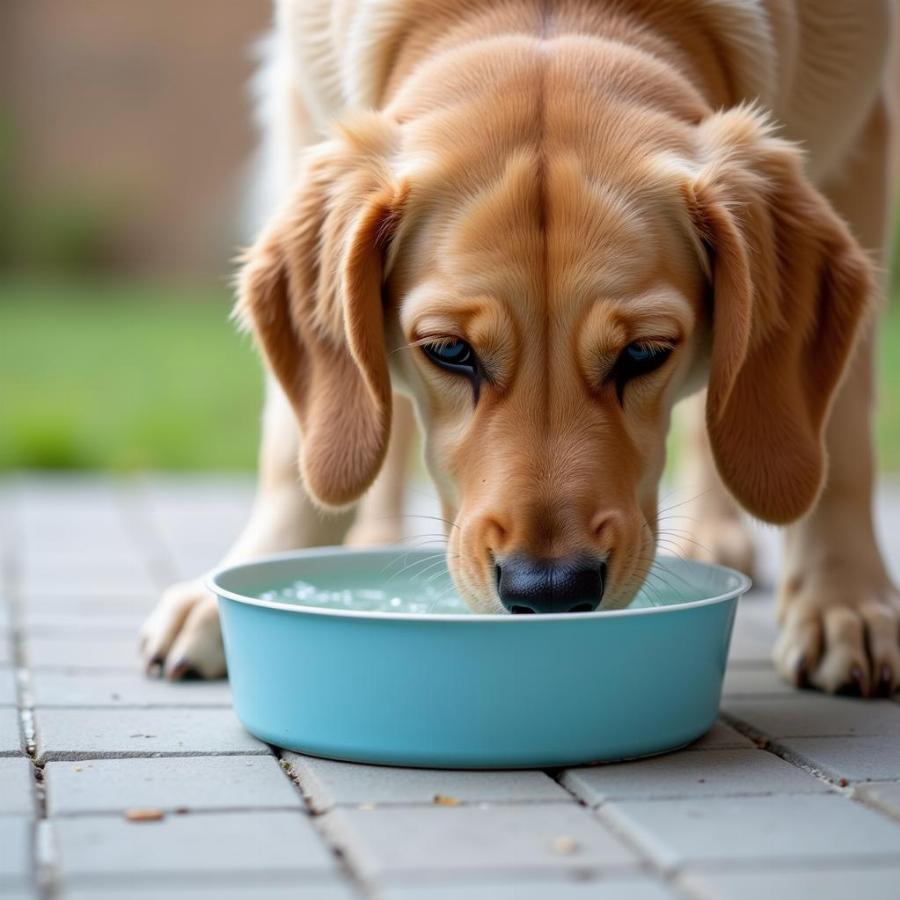Dog urine can have a devastating effect on your beautiful lawn and garden. If you’ve noticed yellow or brown patches where your furry friend frequently relieves themselves, you’re not alone. This article dives deep into the science behind why dog urine kills plants and provides practical solutions to protect your greenery while still allowing your dog to enjoy the outdoors.
Understanding the Chemistry Behind the Damage
Why does dog urine kill plants? The answer lies in its chemical composition. Dog urine is rich in nitrogen, which in small amounts, can actually be beneficial to plants as a fertilizer. However, the high concentration of nitrogen in dog urine is often too much for plants to handle. This overload leads to a “burning” effect, causing those unsightly brown patches. In addition to nitrogen, dog urine also contains salts which can dehydrate plant roots and further contribute to damage. The pH level of dog urine, which tends to be alkaline, can also disrupt the soil’s delicate balance, affecting plant health.
After the first paragraph of the introduction, a fitting image would be of a dog urinating on a patch of grass that is already showing signs of browning.
Identifying the Telltale Signs of Urine Damage
The most obvious sign of dog urine damage is the appearance of brown patches on your lawn. These patches may be surrounded by a darker green ring, indicating an initial surge of nitrogen-fueled growth before the burn sets in. If you’re unsure whether dog urine is the culprit, you might consider other factors like pests or diseases. However, the distinctive pattern of a brown patch often encircled by a darker green ring is a strong indicator of urine damage. You might also notice that the affected area feels dry and brittle to the touch. If you’re experiencing this issue, you might also find the article on “dog urine stains grass” helpful.
Protecting Your Plants from Dog Pee
There are several effective ways to mitigate the damage caused by dog urine. One approach is to train your dog to urinate in a designated area of your yard, preferably one that is covered with mulch or gravel. If that’s not feasible, you can try diluting the urine by regularly watering the areas where your dog urinates. This helps to flush out the excess nitrogen and salts. You may be wondering, “Does dog pee have ammonia?” While dog urine doesn’t contain ammonia initially, it can break down into ammonia in the soil, which also contributes to the damage. Addressing this involves maintaining a healthy soil pH.
A visual aid showing a designated dog potty area would be beneficial here.
Choosing Dog-Friendly Landscaping Options
Another strategy involves choosing plants that are more resistant to urine damage. Hardy groundcovers like clover or fescue are less susceptible than delicate flowers or vegetables. You can also create physical barriers around vulnerable plants using fences or decorative stones. Considering dog-friendly weed control is also important, as some herbicides can be toxic to pets. If your dog tends to eat plants, you should familiarize yourself with the potential dangers of certain weeds by reading our article on “my dog ate weed.”
Ensuring Your Dog’s Health and Hydration
While protecting your plants is crucial, your dog’s health is paramount. Ensure your dog has access to plenty of fresh water. Adequate hydration dilutes the urine, lessening its impact on your lawn. You can also consult your veterinarian about dietary supplements that can help neutralize the pH of your dog’s urine. If you notice your yard smells like dog pee, it might be a sign of frequent urination, which could indicate a health issue.
A picture of a dog drinking water from a bowl would be appropriate after this section.
 Dog Drinking Fresh Water
Dog Drinking Fresh Water
Conclusion
Dealing with dog urine damage to plants can be frustrating, but with a combination of preventative measures and informed choices, you can maintain a beautiful yard and a happy, healthy dog. By understanding the science behind the damage, you can implement effective strategies to protect your plants while still allowing your dog to enjoy the outdoors.
FAQ
-
Can I use fertilizer to repair the damage caused by dog urine? While fertilizer can help restore damaged grass, it’s essential to address the underlying issue of concentrated urine first.
-
Are female dogs’ urine more damaging to plants than male dogs’? The damage is generally similar, although the concentration might vary slightly based on factors like diet and hydration.
-
What are some dog-friendly grass alternatives? Clover, fescue, and synthetic turf are all good options.
-
Are there any products that can neutralize dog urine in the soil? Yes, several products are available that claim to neutralize the salts and nitrogen in dog urine.
-
Can dog urine damage trees and shrubs? Yes, especially young or newly planted trees and shrubs.
-
How can I prevent my dog from urinating on my plants? Training, designated potty areas, and increased water intake can all help.
-
Is it harmful for my dog to ingest plants treated with dog urine neutralizers? Always check the product label and consult with your veterinarian to ensure the product is safe for your pet.
Further Questions?
For more information on related topics, check out these articles: “dog friendly weed control” and “my dog ate weed.”
Beaut Dogs: Your Ultimate Guide to the Canine World
Beaut Dogs is your one-stop resource for all things canine, providing reliable, helpful, and in-depth information on the world of dogs. From breed characteristics to health and nutrition, we’ve got you covered. When you need assistance, don’t hesitate to contact us at Email: [email protected] for detailed and accurate answers. We’re committed to helping you provide the best possible care for your furry friend. Visit https://beautdogs.com today to explore the wonderful world of dogs and learn how to care for them best!